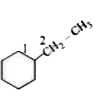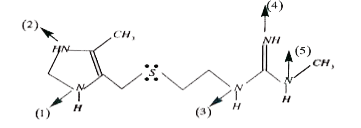C1−C2 bond is shortest inSolution in Telugu
A. 
B. 
C. 
D. 
The correct Answer is:B
Topper's Solved these Questions
- BOOK - AAKASH SERIESCHAPTER - ELECTRONIC EFFECTS AND REACTION INTERMEDIATESEXERCISE - ADDITIONAL PRACTICE EXERCISE (LEVEL - II (LECTURE SHEET ADVANCE)) (Straight ObjectiveType Questions)10videos
ELECTRONIC EFFECTS AND REACTION INTERMEDIATES
- BOOK - AAKASH SERIESCHAPTER - ELECTRONIC EFFECTS AND REACTION INTERMEDIATESEXERCISE - ADDITIONAL PRACTICE EXERCISE (LEVEL - II (LECTURE SHEET ADVANCE)) (More than One correct answer Type Questions)11videos
ELECTRONIC EFFECTS AND REACTION INTERMEDIATES
- BOOK - AAKASH SERIESCHAPTER - ELECTRONIC EFFECTS AND REACTION INTERMEDIATESEXERCISE - PRACTICE SHEET ( EXERCISE-III (LEVEL-II (ADVANCE)) (Integer Type Questions)6videos
ELECTRONIC EFFECTS AND REACTION INTERMEDIATES
- BOOK - AAKASH SERIESCHAPTER - ELECTRON MIGRATION EFFECTS EXERCISE - QUESTIONS FOR DESCRIPTIVE ANSWERS10videos
ELECTRON MIGRATION EFFECTS
- BOOK - AAKASH SERIESCHAPTER - ELEMENTS OF BORON FAMILYEXERCISE - OBJECTIVE EXERCISE - 37videos
ELEMENTS OF BORON FAMILY
Similar Questions
Consider the basicity of the following aromatic amines:
(I) aniline (II) p-nitroaniline (III) p-methoxyaniline (IV) p-methylaniline
The correct order of decreasing basicity is:10:32View SolutionResonance energy will be more if
04:26View SolutionOn mono protonation which nitrogen of the following compound can be protonated.
 04:06View Solution
04:06View SolutionHyperconjugation effect is also termed as 'no bond resonance'. Why?
06:38View SolutionWhich one of the following compounds is not a protonic acid ?
02:44View Solution(C_(0)+C_(1))(C_(1)+C_(2))(C_(2)+C_(3))(C_(3)+C_(4)).........(C_(n-1)+C_(n))=(C_(0)C_(1)C_(2).....C_(n-1)(n+1)^(n))/(n!)
02:05View SolutionC_(0)C_(1)+C_(1)C_(2)+C_(2)C_(3)+...+C_(n-1)C_(n)
08:52View SolutionProve that (C_(0)+C_(1))(C_(1)+C_(2))(C_(2)+C_(3))(C_(n-1)+C_(n))=((n+1)^(n))/(n!)*c_(0)*C_(1)*C_(2).........
05:46View SolutionIf (1+x+x^(2))^(n)=(C_(0)+C_(1)x+C_(2)x^(2)+.........) then the value of C_(0)C_(1)-C_(1)C_(2)+C_(2)C_(3)...
02:53View SolutionIn but-1, 3-diene the C2−C3 bond length is
02:35View Solutionin C_(1)-H, C_(2)-H and C_(3)-H the homolytic bond dissociation energy order is :
02:09View Solution(C0+C1)(C1+C2)(C2+C3)....(Cn−1+Cn)=
View SolutionIf C0+C1+C2+......+Cn=128 then C0−C12+C23−C34+......=
09:24View SolutionIf C0,C1,C2,…,Cn are the binomial coefficients in the expansion of (1+x)n⋅n being even, then C0+(C0+C1)+(C0+C1+C2)+….+(C0+C1+C2+…+Cn−1) is equal to :
View SolutionWhich of the following statements are correct for butadiene
4CH2=3CH−2CH=1CH2
(1) The C1−C2andC3−C4 bonds are longer than a carbon double bond.
(2) The C1−C2andC3−C4 bonds are shorter than a carbon - carbon double bond.
(3) The C2−C3 bond is slightly shorter than a carbon - carbon single bond.
(4) The C2−C3 bond is slightly longer than a carbon - carbon double bond.03:03View SolutionC1−C4 glycosidic bond is NOT found in
02:48View Solution


